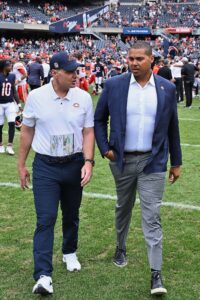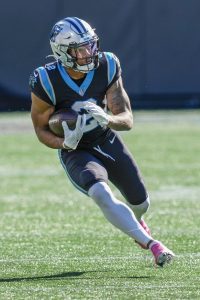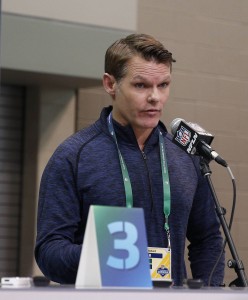The Bears made history Friday by becoming the first NFL team to trade the No. 1 pick in the draft prior to April – since the draft was moved to April in 1976. Their return from the Panthers – four draft picks spread across three years and receiver D.J. Moore – will go a long way in determining both team’s futures for years to come.
Further details have emerged regarding the blockbuster deal, including the negotiating process which led up to the deal being finalized. Talks started at the Combine, with the Panthers being one of a number of teams reaching out to the Bears, per ESPN’s Courtney Cronin and David Newton. That comes as little surprise, considering how willing Bears GM Ryan Poles was to move down the board, given his and the team’s support of quarterback Justin Fields. The ESPN duo add that talks intensified over the past few days, and Friday’s negotiations were sufficient to consummate the trade before the start of free agency this coming week. 
By moving up to the No. 1 slot, the Panthers now have a free choice of the 2023 class’ top quarterbacks. Newton reports, to no surprise, that QB is indeed the position which Carolina will use their top pick on (Twitter link). That will invite plenty of debate and speculation in the coming weeks, as this year boasts a number of intriguing options, but not necessarily a can’t-miss passer. Newton notes that the Panthers were high on Kentucky’s Will Levis at the end of the 2021 campaign, and the performances of Alabama’s Bryce Young and Ohio State’s C.J. Stroud also drew positive reviews from GM Scott Fitterer and Co.
Many have Young, the 2021 Heisman winner, rated as the top signal-caller in the class (which is headlined by the aforementioned three QBs, along with the raw but uber-athletic Anthony Richardson). However, Joe Person of The Athletic reports (subscription required) that Stroud is believed to be in pole position at the moment, one which obviously represents something well short of a final evaluation of any draft prospect on the Panthers’ part. The Buckeyes star put up huge production in his college career, and has long been discussed alongside Young as a blue-chip in the running to become the top passer out of this year’s class.
Interestingly, Newton adds that Carolina could become sufficiently content with more than one QB at the top of the board that they elect to trade down slightly; Person corroborates this (on Twitter). With the Texans (who hold the second overall pick) and Colts (No. 4) each in need of a new signal-caller, moving down any amount would carry a high degree of risk. If the Panthers were assured that at least one of their preferences would be available at their new slot, though, they could use a second trade to recoup some of the capital they spent to acquire the top pick.
Draft maneuvering and the success the Bears have in restocking their roster with the additional picks will be a key determining factor in the legacy of this trade, but the inclusion of Moore has immediate ramifications. Carolina was reluctant at first to include the 25-year-old in the trade package, but Person notes that the Bears viewed him as a “must-have” to finalize the deal (Twitter link). While losing Moore marks a substantial blow to the Panthers’ passing attack, Newton and Person add that his inclusion saved Carolina from having to add another first-round pick to their offer.
The way Carolina approaches their newfound leverage and which passer(s) emerge as their top targets will be an interesting storyline to watch in the coming weeks. The willingness Poles had to move out of the top slot so quickly, meanwhile, will be a key takeaway from the Bears’ perspective as attention will turn to how Chicago uses their added draft capital for the next few years.


